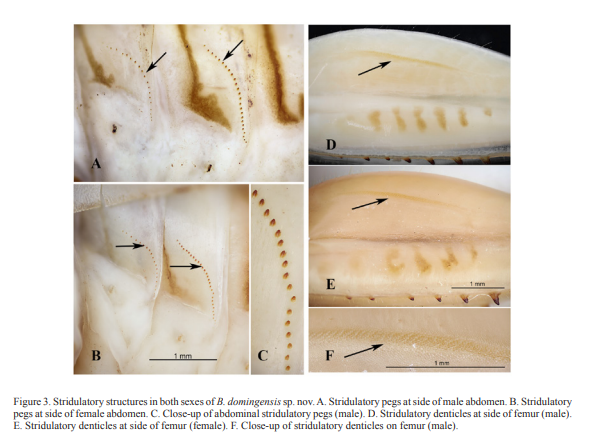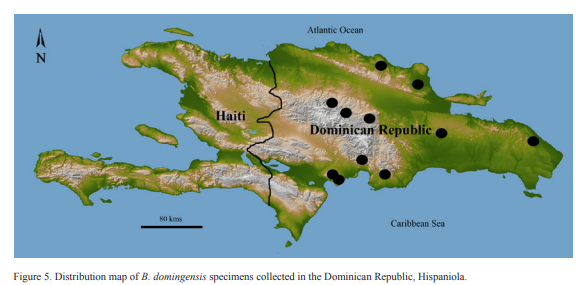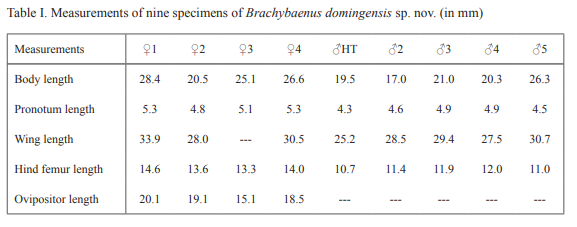INTRODUCTION
Gryllacridids, also known as leaf-rolling crickets or raspy crickets, are a family of very small to very large (5 to over 150 mm) nocturnal insects distinguished from other Ensifera (orthopterans with elongated ovipositors shaped like a sword or a needle, like katydids and crickets) by having anterior tibiae without auditory timpana, four-segmented tarsi, and lacking a stridulatory apparatus at the base of the tegminae. They stridulate for defense and accomplish this by rubbing their femora on chitinous pegs located at the sides of their abdomen. Characteristic of gryllacridids is the production of silk through their salivary glands and they use it to close their shelters of joined leaves. They are omnivorous, scavengers and opportunistic predators. Many species are aggressive and possibly for this reason are mostly solitary (Brunner von Wattenwyl, 1888; Karny, 1937; Rentz, 1996).
The genus Brachybaenus Karny until now includes 17 species in the neotropics from Mexico to Brazil, including Jamaica and Cuba, plus one species and two subspecies found in Indonesia (Cigliano et al., 2018). In the Caribbean islands Brachybaenus is known from the species B. cubensis (Brunner von Wattenwyl, 1888) in Cuba, and B. longstaffi (Griffini, 1909) and B. tapienoides (Karny, 1928) in Jamaica (Table II). Until now, eight species in four genera of Gryllacrididae are recorded from the West Indies: three in the genus Abelona Karny, 1937, three in Brachybaenus Karny, 1937, one in Camptonotus Uhler, 1864 and one in Progryllacris Ander, 1939 (Table II). The only gryllacridid species previously recorded from Hispaniola is Abelona parvula (F. Walker, 1870), (Perez-Gelabert, 2008). Material collected in recent years indicates the presence of several other species in this island.
The reported diversity of gryllacridids worldwide includes some 100 genera and about 882 species (Ingrisch, 2018). The purpose of this paper is to describe a new species of Brachybaenus from the island of Hispaniola.
OBJECTIVE
- To provide the taxonomic description of a new species of Gryllacrididae from various localities in the Dominican Republic.
MATERIAL AND METHODS
Eight of the 11 specimens studied were collected during the Hispaniolan Orthopteroids Project (2002 – 2004) in the Dominican Republic, through nocturnal forays searching shrub vegetation with lights. Specimens were studied under 10 – 60X stereoscopic magnification. Photographs were taken using a Canon Mark II 5D camera and processed using the Visionary Digital (TM) BK Lab Imaging System. The specimens were measured with a digital caliper with resolution to 0.01 mm. Photographs of the three female syntypes of B. cubensis deposited at the Muséum d’Histoire Naturelle, Genève (MHNG), Switzerland were made available. From the newly studied materials, one male and one female of B. domingensis will be deposited in the entomological collection of the Museo Nacional de Historia Natural, Santo Domingo, Dominican Republic (MNHNSD), others are deposited in the Instituto de Investigaciones Botánicas y Zoológicas (IIBZ) and the United States National Museum (USNM) entomological collections.
Depositories
FSCA – Florida State Collection of Arthropods, Gainesville, Florida, United States.
IIBZ – Instituto de Investigaciones Botánicas y Zoológicas, Santo Domingo, Dominican Republic.
MHNG – Muséum d’Histoire Naturelle, Genève, Switzerland.
MNCN – Museo Nacional de Ciencias Naturales, Madrid, Spain.
MNHNP – Museum National d’Histoire Naturelle, Paris, France.
MNHNSD – Museo Nacional de Historia Natural de Santo Domingo, Santo Domingo, Dominican Republic.
MRSN – Museo Regionale di Scienze Naturali di Torino, Turin, Italy. NHM – The Natural History Museum, London, England.
NHMW – Naturhistoriches Museum Wien, Austria.
OUMNH – Oxford University Museum of Natural History, Oxford, England.
USNM – United States National Musem of Natural History, Smithsonian Institution, Washington, DC, United States.
TAXONOMY Superfamily Stenopelmatoidea Burmeister, 1838 Family Gryllacrididae Blanchard, 1845 Subfamily Gryllacridinae Blanchard, 1845
Genus Brachybaenus Karny, 1937 Brachybaenus domingensis sp. nov.
Figures 1-5
Holotype. 1 ♂, DOMINICAN REPUBLIC RD-045 Paso de la Perra, nr. La Ciénaga, La Vega Prov., 19º04.576’N 70º49.623’W, 16.vii.2002. D. Perez, B. Hierro, R. Bastardo, S. Medrano, H. Takizawa (USNM).
Diagnosis. Brachybaenus domingensis can be distinguished from its likely closest congener (B. cubensis) most obviously by both sexes having a mostly pale yellowish face with only small black markings around the lower margins of the frontal ridge. The spines of anterior tibiae are little curved and shorter than the length of one eye. Both sexes have long wings that extend beyond the abdominal end. In B. cubensis females have a face that is mostly black with the rounded ocelli yellow, the spines of the anterior tibiae are more curved and longer than the length of one eye and have shorter wings (barely surpassing the abdominal end).
Diagnosis. Brachybaenus domingensis puede distinguirse más obviamente de su probable congénero más cercano (B. cubensis) por ambos sexos tener la cara amarillo pálido solo con pequeñas marcas negras alrededor de los márgenes inferiores de la cresta frontal. Las espinas de las tibias anteriores son poco curvadas y más cortas que el largo de un ojo. Ambos sexos tienen alas largas que se extienden más allá del extremo abdominal. En B. cubensis las hembras tienen la cara mayormente negra con los ocelos redondeados de color amarillo, las espinas de las tibias anteriores son más curvadas y más largas que el largo de un ojo y tienen alas más cortas (que apenas sobrepasan el extremo abdominal).
Etymology. The epithet domingensis, refers to the island of Santo Domingo or Hispaniola inhabited by this species.
Description
Body size. Medium size but somewhat robust orthopterans (see measurements in Table I), with full wings that in both sexes extend well beyond the abdomen (Figs. 1A-C).
General coloration. Body color yellowish-brown, marked by dark brown to black spots mainly on head, pronotum and hind femora. Wings darker brown with conspicuous venation.
Head. Short, with fastigium not produced beyond the bases of antennae, with dark reddishbrown to black patches around the eyes that concentrate on the vertex; patches more strongly marked behind the eyes, dorsally leaving a less-marked space in its center (Figs. 2C-D). Face light yellowish only marked with small brownish spots to the sides of a round central ocellus (Figs. 2A-B). Eyes not protruding, somewhat oval-shaped vertically. Frons smooth, with clypeus somewhat quadrate, narrower at its lower portion. Labrum smooth and rounded (Figs. 2A-B). Palps very long (Fig. 1B).





Measurements. See Table I.
Paratypes. Preserved dry: 1 ♀, DOMINICAN REPUBLIC RD-005 15.i.02 Las Yayitas, Azua Prov., 240 m, 316-230 mE 2046-941 mN. D. Otte, D. Perez, R. Bastardo, S. Medrano (MNHNSD); 1 ♀, DOMINICAN REPUBLIC RD-044 La Sal, Reserva Científica Ebano Verde, La Vega Prov., 11-12.vii.2002, 19º04.101’N 70º34.089’W, 1,043 m, D. Perez, B. Hierro, R. Bastardo (USNM); 1 ♂, DOMINICAN REPUBLIC RD-051 Alto del Rancho, Loma Guaconejo, M. T. Sánchez Prov., 170 m, 24-25.vii.2002, 19º18.752’N 69º56.663’W, D. Perez, B. Hierro, R. Bastardo (USNM); 1 ♂, DOMINICAN REPUBLIC RD-126 Caseta Parques en Diferencia, PNAB, Santiago Prov., 740 m, 19°16.313’N 71°03.132’W, 8.iv.2003, D. Perez, R. Bastardo, B. Hierro (USNM); 1 ♂, DOMINICAN REPUBLIC , Prov. Monte Plata, Parque Nacional de la Biodiversidad, 18.88785N 69.73174W, 200 m, 2-v-2015, J. A. Sánchez Borbón (IIBZ); 1 ♂, DOMINICAN REPUBLIC Pr. La Altagracia, Nisibón Finca Papagayo 4-7-IV-2000, blacklight trap, 150’ RE Woodruff, TJ Henry (FSCA). Preserved in alcohol: 1 ♀, DOMINICAN REPUBLIC RD-221 ~8 km S Bombita, Parque Nacional El Choco, beside karst mogote, Puerto Plata prov., 144 m, 19º43.249’N 70º28.216’W, 14.iv.2004, D. Perez, B. Hierro, R. Bastardo. (d/n) (USNM); 1 ♀, DOMINICAN REPUBLIC RD-153 La Poza de Agua Nueva, El Curro, Sierra Martín García, Azua Prov., 18°18.324’N 70°57.176’W, ~800 m, 15-16.vii.2003, D. Perez, R. Bastardo, B. Hierro. (day/night) (USNM); 1 ♂, DOMINICAN REPUBLIC RD-156 La Furnia, Barreras, Azua Prov., 18°19.289’N 70°54.755’W, 18.vii.2003, D. Perez, R. Bastardo, B. Hierro. (night) (USNM). 1 ♂, REPUBLICA DOMINICANA, Prov. Peravia, Baní, Honduras, Los Cedros, 351473 mN 2036495 mE, 656 msnm, 23/x/2009, G. de los Santos (MNHNSD).


DISCUSSION
The general similarities (size, robustness, general coloration, markings, tibial spines) between B. cubensis and B. domingensis suggests that they might be close relatives. Although there was no opportunity to examine the two Jamaican species (B. tapienoides and B. longstaffi), the smaller biogeographical affinity between the islands of Jamaica and Hispaniola suggests a more distant relationship.
Individuals of B. domingensis are encountered only haphazardly while searching vegetation at night (each specimen reported here is from a different locality), so they seem widely distributed, inhabiting varied conditions of humidity and elevation. The elevation of the localities varied from near sea level (Nisibón) to as high as a thousand meters (La Sal, Cordillera Central). Although both sexes of B. domingensis have long wings, it is unclear whether these relatively heavy gryllacridids can fly as they never appeared inclined to do that. Their behavior before becoming aware of the collector often suggested that they were foraging, rapidly moving along small branches at night apparently searching for prey. No example of the nest or hideout of this species was found.
ACKNOWLEDGEMENTS
Karolyn Darrow (Department of Entomology, NMNH, Smithsonian Institution) produced the photographs. John Hollier (Muséum d’Histoire Naturelle, Genève) graciously provided photographs of the B. cubensis syntypes deposited in their collection. Carlos de Soto Molinari (Santo Domingo) is acknowledged for the picture of the live specimen.
